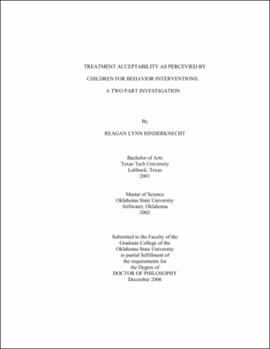| dc.contributor.advisor | Mesmer, Eric M. | |
| dc.contributor.author | Rinderknecht, Reagan Lynn | |
| dc.date.accessioned | 2013-11-26T08:27:45Z | |
| dc.date.available | 2013-11-26T08:27:45Z | |
| dc.date.issued | 2006-12 | |
| dc.identifier.uri | https://hdl.handle.net/11244/6972 | |
| dc.description.abstract | Scope and Method of Study: The purpose of the study is to investigate variables that may influence children's treatment acceptability of behavior interventions. An additional objective is to examine if a causal relationship exists between treatment acceptability and treatment effectiveness. One-hundred and eighty three children participated in part one of this study, and seven children participated in part two of this study. | |
| dc.description.abstract | In part one of the study, each child was presented four behavioral interventions. They were then asked to rate the treatment acceptability of each intervention using the Children's Intervention Rating Profile (CIRP). Teachers were asked to rate the behavior severity of up to six randomly selected students in their classroom using the Conner's Teacher Rating Scale: Revised-Short Form (CTRS:R-S). They were also asked to complete the Effectiveness Rating Profile(ERP) of the Behavior Intervention Rating Scale (BIRS) for children who they had run classroom behavioral interventions with during the previous school year. | |
| dc.description.abstract | In part two of the study, each child was originally nominated by their teacher based on a high incidence of classroom behaviors including, talking out, being out of seat and/or being passively off task. Individual behavioral interventions were then implemented in the classroom by the child's respective teacher. An ABCACB single-subject design was utilized in this part of the study. Children experienced two versions of an intervention, a more acceptable version (phase B) and a less acceptable version (phase C). Children were asked to rate the acceptability of the intervention prior to the start of each treatment phase using the CIRP. Treatment effectiveness data was gathered using interval-time sampling procedures on a daily basis. | |
| dc.description.abstract | Findings and Conclusions: Results revealed that children in grades one through four found positive and negative reinforcement interventions significantly more acceptable than type I punishment interventions. Grade did not significantly influence treatment acceptability ratings. Small to medium correlations were found between behavior severity levels of children and treatment acceptability ratings. In addition, a causal relationship was not found to exist between treatment acceptability and treatment effectiveness for most subjects. Previous experience was found to influence treatment acceptability following intervention exposure. | |
| dc.format | application/pdf | |
| dc.language | en_US | |
| dc.rights | Copyright is held by the author who has granted the Oklahoma State University Library the non-exclusive right to share this material in its institutional repository. Contact Digital Library Services at lib-dls@okstate.edu or 405-744-9161 for the permission policy on the use, reproduction or distribution of this material. | |
| dc.title | Treatment acceptability as perceived by children for behavior interventions: A two-part investigation | |
| dc.contributor.committeeMember | Stinnett, Terry A. | |
| dc.contributor.committeeMember | Duhon, Gary | |
| dc.contributor.committeeMember | Davis, C. Robert | |
| osu.filename | Rinderknecht_okstate_0664D_2029.pdf | |
| osu.accesstype | Open Access | |
| dc.type.genre | Dissertation | |
| dc.type.material | Text | |
| thesis.degree.discipline | Educational Psychology | |
| thesis.degree.grantor | Oklahoma State University | |
